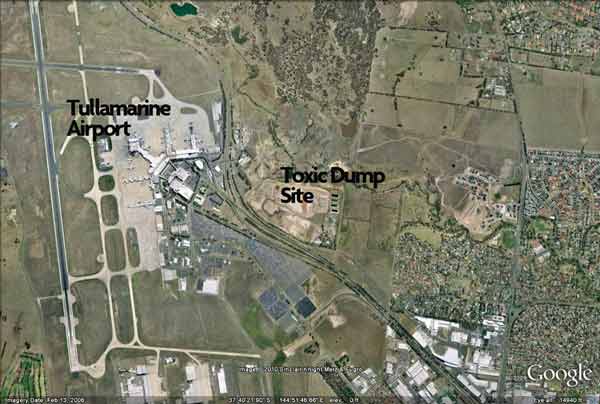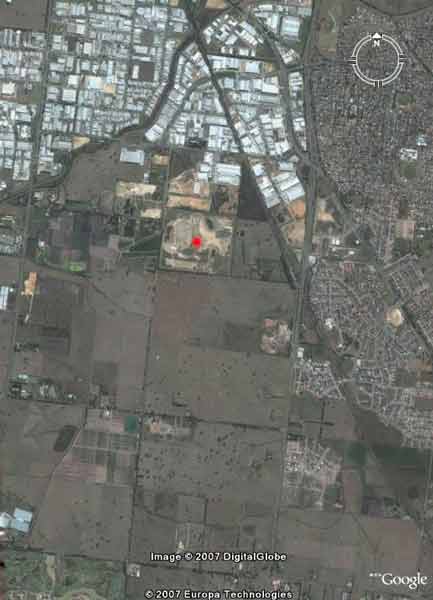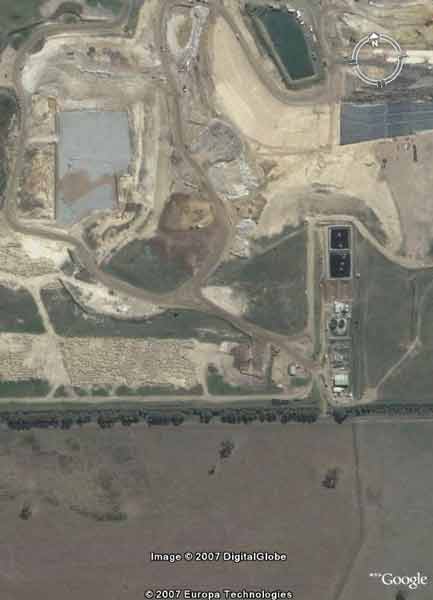EXPOSING DEVELOPERS WHO FAIL TO APPRECIATE AND RESPECT COMMUNITY, ENVIRONMENT AND SPIRIT OF THE LAND
New Toxic Waste site was to be built at Baddaginnie (north east Vic) and Hattah/Nowingi in north western Vic in 2004-6.
Both options dumped - But Nightmare Continues in Melbourne.
Check Out Envirowest's Informative Website
Feb 15 2011: EPA douses cancer fears near Melbourne toxic dump
Response to Minister Jennings re the Cancers and the Tullamarine Toxic Dump (August 2010)
February 16 2011: Builders Want New Soil Dump Site
July 27 2010: Minister 'Must Go' Over Tulla Toxic Dump Fears
July 21 2010: Calls For Minister's Resignation Over Toxic Scare Comments
July 20 2010: Cancer Rates Near Dump Under Review
July 19 2010: Jennings downplays toxic dump cancer link
July 19 2010: More Health Fears Near Closed Toxic Dump
July 19 2010: Fresh cancer Fears For Residents
June 10 2010: Watchdog Fails On Waste
June 9 2010: EPA Slammed Over Hazardous Waste
May 17 2010: Tulla Toxic Dump Fight
May 13 2010: Waste Tip Blamed For Cancers, Birth Defects
May 13 2010: Health Study To Examine Toxic Waste Concerns
May 12 2010: Survey Points To cancer Waste Dump Link
May 12 2010: Tullamarine Toxic Dump Causes Cancer Concerns
March 25 2010: Probe Into Dandenong Waste Dump
February 25 2010: Toxic Dump Deformity Cancer Fear At Dandenong South Hazardous Waste Zone
July 27 2008: Clampdown on Toxic Waste
July 20 2008: Toxic Waste Buried in City
June 24 2008: Tullamarine Toxic Tip Sale
May 20 2008: Toxic Triumph Celebrations At Closure of Tullamarine Landfill
April 21 2008: Lyndhurst Tipped To Take Desal Sludge
Feb 8 2007: Lyndhurst Given A Life: The Ongoing Sage of Toxic Waste in Victoria
Nov 8 2000: Toxic Waste Dump In Melbourne
Who are the biggest producers of toxic waste in Victoria?
Plastics: |
BASF, Nalco, Dupont |
Automotive: |
Ford, General Motors, Toyota |
Steel: |
Sims Metals, Smorgans(?) |
Other Metals: |
Alcoa, Comalco |
Petroleum: |
Mobil, Shell |
But Lyndhurst and Tullamarine Toxic Dumps continue.
Lyndhurst Toxic Waste Dump (south east Melbourne region). Note close proximity to suburbs of Hampton Park (right of screen) and Dandenong South (left of screen).
Close up of Lyndhurst Toxic Waste Facility located in the Eumemmerring Creek catchment which flows into the Patterson River and eventually Port Phillip Bay at Carrum.
Toxic dump set to close by 2009 March 3, 2007 The Age
Alternative site built on fault line by Royce Millar
One of Victoria's two remaining toxic waste dumps will close within two years, with the Environment Protection Authority giving its clearest indication yet that it will reject plans to expand one of the dumps on Melbourne's north-west.
Pressure to find an alternative to the remaining dump on the south-east is also mounting, with the revelation that the Lyndhurst site is on an earthquake fault line.
EPA chairman Mick Bourke said yesterday that he expected the controversial Tullamarine landfill would close within two years, despite the State Government scrapping plans for replacement at Nowingi, near Mildura.
"The life of the Tullamarine landfill for prescribed industrial waste is not very long, maybe a couple of years," he said. "Most of our eggs will be in the Lyndhurst basket from about two years onwards."
The EPA has put off a decision on the application to expand Tullamarine while operator Cleanaway negotiates with the Hume City Council over a planning permit. But the council looks set to refuse permission, a decision that Mr Bourke said the EPA would back.
In January the Government abandoned its $14.6 million search for a new toxic-waste store and its preferred site at Nowingi, after an independent panel rejected the site. Waste will continue to go to a landfill at Lyndhurst, near Dandenong, and to Tullamarine.
Residents and councillors have waged a long campaign for the Tullamarine landfill to close.
Among a list of claims is an unusually high local cancer rate. Two years ago, The Age also revealed that pollutants from the landfill were contaminating Moonee Pond Creek.
Yesterday Tullamarine anti dump campaigner Kaylene Wilson said that she would be "very very happy" if Mr Bourke's comments amounted to a guarantee that the dump's end was near.
But the closure of Tullamarine will add both waste pressure and political focus to the remaining dump at Lyndhurst.
Lyndhurst residents were furious about the Nowingi decision, arguing that they had borne the brunt of a politically expedient decision.
This week residents started to turn up the heat with a revelation, confirmed by earthquake experts, that the Lyndhurst site sits almost directly on top of the Selwyn fault line. It runs from the Dandenongs through Melbourne's south-east to the Mornington Peninsula.
A petition of more than 2500 locals calling for an end to Lyndhurst was tabled in Parliament last week.
Under its new waste strategy, the Government is banking on a rise in levies to make state-of-the-art treatment technology viable. It is also encouraging industry to cut the 89,000 tonnes of industrial waste that are produced in Victoria annually.
Yesterday Lyndhurst local Thelma Wakelam was scathing about the Government's belief that waste would be reduced to the point where it was no longer an issue. "They can never reduce it to the degree where there is no residue," she said. "There will always be toxic waste and it will always need a safe location."
Response to Minister Jennings re the Cancers and the Tullamarine Toxic Dump (August 2010)
“No Mr Jennings, you were not quoted out of context”
After making totally inappropriate and insensitive comments about the substantial number of cancer cases reported in close proximity to the Tullamarine hazardous waste landfill, the Minister, Mr Gavin Jennings, tried to excuse himself by claiming that the media had quoted him out of context. As shown below (transcribed directly from ABC radio and TV recordings) Mr Jennings was not misquoted by the media.
Confronted with the second health report about cancers in proximity to the Tullamarine toxic dump, the Minister’s response was:
“You have to understand that many people have moved into this locality whilst the landfill was operating. Many people have exercised their choice to live there”
and
“All the health issues that you have just identified now are a feature of daily life for, unfortunately, thousands of people around the world whether they live near a landfill or whether they don’t”
The Minister has a statutory responsibility to ensure that the environment is protected, through his various agencies, especially the EPA. Under the Act he must oversee EPA activities and ensure that EPA performs as required to protect both environment and human health, without fear or favour.
It is not an excuse for failure to do so to now claim that cancers are “a feature of daily life” or that “many people exercised their choice to live there”. Regardless of why people chose to live there (and Mr Jennings is clearly ignorant of the facts) it remains his responsibility to ensure that the landfill does not have any hazardous emissions beyond its borders.
He has known for many years that the landfill has leaked and emitted gases beyond its borders. He has failed to act to ensure the safety and health of both environment and the community, despite many requests, both private and public, to do so.
There is no “context” that can justify the comments made by the Minister in attempting to deny his responsibility for the many failures of the EPA at Tullamarine. On the contrary, the Minister’s assertion that people chose to live there is tantamount to an admission that the Minister does not consider himself responsible for protecting such people from possible health impacts from the landfill. He is blaming the victim to hide his own failures.
These failures are further evidenced by the report from the Ombudsman over the Cranbourne landfill crisis and the Auditor General over the mismanagement of hazardous waste in Victoria.
We call on the Minister to do one of two things: either resign in accordance with traditional Westminster expectations in the face of such failures of responsibility and in light of his totally and seriously inappropriate and disgraceful comments, or show the community that he is genuine about rapidly finding effective solutions to the problems his negligence created and is competent to do so.
The most immediate step the Minister must now take is to assure the community that the purpose of the “independent” review of the Tullamarine hazardous waste landfill to which he consistently refers now (but refused for many years) will provide a considerably better cap than the one currently proposed.
It is not acceptable for the Minister to hide behind a “review” that does not from the outset intend to significantly improve the cap or the gas and leachate management system. The landfill is already leaking and is already discharging gases into the local atmosphere – the only justification for a review is to significantly improve the situation. The Minister has so far refused to make this the aim of the review. Instead he has continued to defend the third-rate cap currently being constructed and appears to be using the “review” as a smokescreen for “Business as Usual”. Requests for a moratorium on current construction while undertaking the “review” have been rejected.
The people of Tullamarine in particular, and all Victorians in general, need a clear show of commitment for a substantial improvement in performance from the Minister – we need actions not words – we can no longer tolerate a Minister who delays while the inadequate capping and management systems continue.
Below are some extracts from the letters of several residents angered by the Minister’s comments who subsequently wrote to the Minister:
“We thought when we moved from Eltham to Westmeadows the location was zoned RESIDENTIAL and we would live in safe surroundings, but obviously we were wrong. I made this one mistake. I also made the mistake in believing that the EPA and the Government represented the community and were concerned with safety and the environment, what a fool I have been, but after Mr Jennings comments on the ABC (19-7-2010) I have woken up.”(Male resident)
“I can't believe you guys, you tell me the EPA is going to do a health study with the Cancer Council before the end of the year. But it wasn't that long ago you were saying there had been a health study done in 2006 and it showed no problems.
Now you’re telling me that operations and the cap at the dump are going to be reviewed. GREAT, but it wasn't that long ago that the residents were complaining to the EPA and Government about the operations and cap design at the dump. Yet not that long ago the residents were told by the EPA and Government that the cap was world’s best practice, no problem, it had already been reviewed.
Well which world were they talking about, give us a break, we are not that stupid.
We can't change what has been done, but we can stop it from getting any worse.
To do this we need action and we need it now. We need you to stand up and be counted.” (Male resident)
and
“ I can’t believe how a Labor Minister [Gavin Jennings] could say something as ignorant and inflammatory as telling this community that we chose to live here!
Doesn’t he realize that most of the people were here a long time before the Government decided to dump toxic chemicals just outside their front door, without their permission?
To be dismissed like this in a community which has always voted for you because they believed that you would fight for our right to clean air, is very painful.
Sure, cancer is a part of life, but it doesn’t have to be amplified four-eightfold, or more, because governments have more regard for big business than they do for human life and the environment.” (Female resident))
and
“Mr Jennings. You are an absolute disgrace.
I, like many others, moved to this area before a lazy Victorian Government decided to dump the deadly toxins and poisons into a leaky hole in the ground next to the fast growing housing estates of Gladstone Park, Tullamarine and parts of the old Township of Westmeadows rather that find safe and proper disposal methods.
Your callous comments, reported by the ABC, about the health concerns of the residents, past and present, living in the shadow of the Toxic Waste Dump demonstrate conclusively that you are unfit for public office.” (Male resident)
“. . . , please be very aware that these reviews are only taking place because of the dedication and hard work of the Terminate Tullamarine Toxic Dump Action Group (TTTDAG), its supporters and the community.
I have been present at numerous meetings where previously the EPA have treated the aforementioned with such contempt that it was hard to believe a democracy was in existence.
Recommendations for a "World’s best practice cap" were ignored and disrespected as was information regarding toxic leakage. However persistence, patience and correct information researched by TTTDAG and its supporters have thankfully and hopefully made a pathway for common sense to prevail.” (Female Resident)
Prepared by Harry Van Moorst, Western Region Environment Centre, 9731 0288 and 0431 121218
Also see here for another Gavin Jennings Botch Up
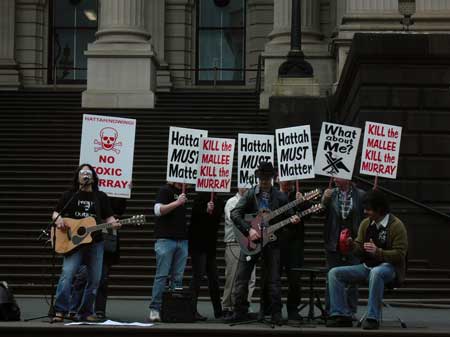
July 27, 2006: Protest performance outside Parliament House
The Sorry Tale of Hazardous Waste in Victoria (Here).
Stateline ABC TV Friday May 6 2005 see here.
MEDIA RELEASE
Environment Groups Call on Government to abandon Hattah EES 13/04/2005
The Alliance for the Appropriate Management of Hazardous Waste, comprising Victoria’s peak environmental groups, today wrote to the Premier urging him to abandon the Hazardous Waste EES.
The Alliance stated that there was already overwhelming evidence that the project cannot go ahead at the Hattah/Nowingi site. The Alliance has requesting a meeting with the Premier to discuss a positive way forward in implementing the Government’s hazardous waste policy.
“This EES is wasting tax payers’ money as it cannot now possibly give the project the green light,” claimed Marcus Godinho, Director of Environment Victoria.
“The Hattah/Nowingi site has been classified as being of the highest ecological value, even by the Government’s own consultants. There is no justification for placing any kind of hazardous waste facility there and there is no way that it can accord with environmental legislation, let alone meet community expectations,” he said.
Charlie Sherwin, from the Victorian National Parks Association agreed. “We already know there are insurmountable barriers to establishing the hazardous waste facility at the Hattah site, especially the flora and fauna issues. We know it would have unacceptable impacts on the area and could bring the Mallee Emu wren close to the brink of extinction. There is no need for an EES to progress any further,” Mr Sherwin said.
Harry van Moorst, from the Western Region Environment Centre, also expressed concern about continuing with the Hattah/Nowingi EES. “If the Government is serious about implementing its Hazardous Waste policy then it must abandon the EES for Hattah/Nowingi and abandon the landfill technology being proposed by Major Projects (MPV).” Mr van Moorst said.
New toxic waste site planned to be built at Hattah/Nowingi in north western Victoria.
Statement to the Victorian Government regarding the Proposed Hazardous Waste Facility
We the undersigned, wish to express our concerns about current proposals for management of hazardous or prescribed industrial waste, and to suggest an appropriate way forward. We do this in support of the Prescribed Industrial Waste Policy adopted by the Government in December 2000.
Our concerns
We are extremely concerned about the proposed site at Hattah/Nowingi because it is high quality, old-growth mallee of the type required by many threatened species. Malleefowl and Mallee Emu-wren have been recorded on the proposed site this year. Black-eared Miner have been recorded on the site historically (1994) and 1.5 km from the proposed site in 1998. Indeed, under the EPBC Act 1999, the proposal is considered likely to have a significant impact on these three species of bird. The conservation of these species, particularly through retention of habitat, is critically important at a state, national and international level. In addition to being very important habitat in its own right, the Hattah/Nowingi site selected by Major Projects Victoria (MPV) also forms an important wildlife corridor between the Hattah-Kulkyne National Park and the Murray Sunset National Park.
We are also concerned about the distance of the proposed site from the main sources of the hazardous waste. This is contrary to sustainability principles due to resource and greenhouse gas emission considerations as well as being contrary to the Government’s siting criteria which explicitly require consideration of proximity to waste generators.
The MPV/GHD paper discussing the technology for the site is tantamount to a landfill proposal, rather than a containment proposal (which requires adoption of modern engineering alternatives) and contrary to a Government commitment to abolish land filling of prescribed waste. The failure to provide innovative alternatives to landfill will make it virtually impossible to find a viable and acceptable site for the facility.
MPV has conducted the siting and technology process without effective consultation and serious credibility-sapping mistakes have been made, such as the failure of the initial three sites, initially promoted as "the best in Victoria". The process has not been transparent or open and this has seriously undermined the Government’s credibility on this issue.
Our recommendations
We believe that greater effort is needed to reduce waste generation at source. Nonetheless, we are also members of the Victorian community and are contributors to the burden of hazardous waste in our State. Not losing sight of the fact that it is only a ‘last resort’ solution to a long-term problem, we recognise that establishment of a containment facility is presently necessary and would support such a development if it was appropriately designed and sited.
We believe, however, that strenuous efforts need to be made now to remedy the situation facing the Government’s Prescribed Industrial Waste Policy if this is to meet the satisfaction and support of this coalition, its wider membership and the Victorian community. The imminent closure of Tullamarine and the urgent need to close the hazardous waste landfill located at Lyndhurst, in accordance with Government policy and siting criteria for hazardous waste facilities, require a timely and considered response from Government. Any such response must accord with existing policy and must not be a knee jerk reaction to a tight time frame. The failure of MPV to implement the policy over the past three and a half years, and in particular its alienation of organisations such as ours that are supportive of the proper implementation of the policy, should lead to a sensible review of current strategy.
We would like to assist the Government with this review by proposing the following:
1. The Government recognise that the implementation of its Prescribed Industrial Waste Policy requires a whole-of-Government approach involving a number of departments, including DSE, DPI, Treasury, Planning, MPV and specific agencies such as EPA. To provide a coherent and coordinated approach it is important to locate the overall project within the Department of Premier and Cabinet.
2. The Government expand the Prescribed Waste Project under the direct auspices of the Department of Premier and cabinet, to conduct an open and inclusive process for establishing both alternative technologies and alternative sites to those currently proposed by MPV. Our own investigations suggest that this process could work within a 6-month time frame if it is adequately and skilfully resourced.
3. The EES be expanded to include the alternative sites and technologies that result from the review.
4. The Government work with the environmental movement, industry, local government and other stakeholders to obtain maximum community acceptance of the existing policy and subsequently of the outcomes of the 6-month review of options.
We urge the Government to recognise the current failures in the implementation of its Prescribed Industrial Waste Policy and to take strong action to rectify the situation. Unless public confidence is restored there will be no solution to our prescribed waste problems.
As organisations concerned with Victoria’s environment and with a strong network amongst the Victorian community we support in principle the implementation of the Government’s Prescribed Industrial Waste Policy but have no choice but to vigorously oppose the siting and design proposals currently being pursued by MPV, for the reasons discussed above.
Australian Conservation Foundation, Birds Australia, Environment Victoria, Friends of the Earth, National Toxics Network, Residents Against Toxic Waste in South East, Save the Foodbowl Alliance, The Wilderness Society, Victorian National Parks Association, Western Region Environment Centre.
(see images of potential future waste site below including photos of Yam Daisies and Spider Orchids).
 |
 |
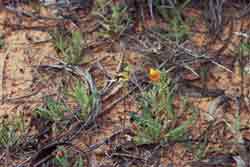 |
 |
QUOTES OF THE YEAR
"A number of old and existing landfills are situated in close proximity to each other in the Clayton South area about 20 km south-east of Melbourne. The leachate from these landfills is polluting high quality groundwater aquifers. This threat to groundwater resources is triggered by the landfills being located above unconsolidated sandy aquifers. Another aspect which further complicates the issue is that sand mining in the area has artificially depressed the groundwater. Given these conditions each landfill has a different type of containment system and the groundwater monitoring requirements vary for each. The main issue now is to establish the severity of the environmental impacts and how to protect the groundwater resources in this area from these impacts..." (EPA Victoria)
"The specification for landfill caps to meet regulations has become ever more prescriptive over the years. This reflects the regulatory goal of providing ever greater protection for the environment from leachate excursions through basal liners, which are driven by hydrostatic head resultant from rainfall infiltration through the cap. Cap specifications also seek to improve gas-harvesting potential. Current Victorian Guidelines (so called Best Practice) specify the use of geomembrane layers in the cap as well as in the basal liner as well as a series of layers of different layers each with specific purposes. All of this is very expensive and questionable in effectiveness. Recent data compiled by Bonaparte and others (2002) for the US EPA show that even with multiple geomembrane layers in the basal liner, leachate leaks through the upper geomembrane barrier layer. Average leakage rates ranged between: 5 and 440 l/ha-day during initial landfill operation (a few lifts with only daily cover). 1 and 360 l/ha-day during the active period of landfill operation (intermediate cover). 2 and 60 l/ha-day after closure of the landfill cell. In addition, landfill operators are looking at up to 30 years of post closure management and the provision of very significant financial assurances which must be maintained over this time to provide for any failures in the engineered systems that may occur in that period. These aspects add to the cost of the period at a time when there is no income from the site..." (Sustainable Landfill Design by Monitoring & Managing Cap Infiltration. Jorgenson, Hancock, Fox-Lane, Gallagher, Buss)
The Sorry Tale of Hazardous Waste in Victoria by Harry van Moorst
Chain Reaction (The National Magazine of Friends of the Earth Australia) Issue #95 Summer 2005/06
BACKGROUND
From Mildura to Swan Hill, North West Victoria is gearing up for a massive fight against the State Government's proposed "toxic dump" at Hattah/Nowingi, about 500km north-west of Melbourne.
Nearly seven years earlier, in May 1998, more than 15,000 braved a cold Monday night at the Werribee Racecourse to forcefully tell the Kennett Government that they would strenuously fight the proposed "toxic dump" in Werribee.
This massive community meeting culminated a two-year campaign organised by Werribee Residents Against Toxic Dumps (WRADT) during which a range of tactics were used to promote an integrated stratgy to defeat the CSR/Kennett Government proposal.
The WRADT campaign included a substantial attack on the CSR Environmental Effects Statement. The campaign geared up several notches when the Government-appointed EES Panel delivered its report in early 1998 in support of the Government and CSR.
After large rallies and meetings, boycott campaigns, harassment of Government Ministers at election meetings and many other tactics, the Werribee community was successful in defeating the proposal. This forced the Kennett Government to admit it had no effective hazardous waste management policy.
The impact of the WRADT campaign went well beyond the traditional 'NIMBY' campaign. The organisers went to great lengths to argue that if it wasn't good enough for Werribee's back yard then it wasn't good enough for anyone's back yard. The campaign placed considerable emphasis on developing alternative policies including alternatives to landfill technology for storing unavoidable wastes.
Ironically, while the EES Panel wholeheartedly supported the CSR proposal, the final outcome was a change in policy in accordance with the alternatives that WRADT had put before the EES Panel in the first place.
Working with the Environment Protection Authority (EPA) and a Government-appointed advisory committee, the Werribee activists succeeded in getting bi-partisan support for a new policy which banned future landfilling of hazardous waste and for the first time established criteria for the siting of hazardous waste facilities.
By December 2000 these new policies were promulagated and the scene was set for major improvements in hazardous waste management, including waste reduction, recycling and the long-term containment of unavoidable waste. Such containment would be in scientifically engineered containment facilities, not in landfill, and would be cited in accordance with the new siting criteria.
Five years later there are still no contaminated soil recycling facilities, no long-term containment facilities and only marginal gains in hazardous waste minimisation.
Instead of the promised reforms we find the Government has approved extensions of the Tullamarine and Lyndhurst landfills to enable continued dumping of hazardous waste. Something went wrong!
THE SCOPE OF THE PROBLEM
Each year Victorian industry produces about 120,000 tonnes of hazardous waste. This includes 30,000 - 40,000 tonnes of contaminated soils, much of which can be readily recycled, but at a financial cost. The rest is comprised of a range of wastes, some of which could be avoided, some can be recycled, some can be treated to be non-hazardous and some has to be safely stored for an indefinite period of time. All this is practical, but again at a financial cost.
Traditionally, this material has been dumped into landfill, mainly at Tullamarine and Lyndhurst. Landfill in Victoria is very cheap compared with the more responsible ways of avoiding or managing hazardous waste.
The problem with cheap landfill is two-fold: it acts as a formidable disincentive to developing more environmentally responsible, sustainable and safer technologies, and equally importantly, landfills will sooner or later leak their contents into the environment. Even the US EPA admitted in 1988 that "Even the best liner and leachate collection system will ultimately fail due to natural deterioration... Once the unit is closed, the bottom layer of the landfill will deteriorate over time and, consequently, will not prevent leachate transport out of the unit".
THE BUREACRACY TAKES OVER
Since 2001 the Government has entrusted the implementation of its hazardous waste policy (formally the Prescribed Industrial Waste Policy) to EPA and Major Projects Victoria (MPV): the EPA is responsible for actual policy content including the standards and regulations, while MPV was charged with providing the required infrastructure, such as the soil recycling and long-term containment facilities.
Initially advised by a broad Advisory Committee, MPV asked industry to nominate sites for a soil recycling facility. Not surprisingly the industry-proposed sites were overwhelmingly inappropriate (e.g. within 500m of a kindergarten or with 10,000 residents within the proposed buffer zone) - industry had only nominated sites convenient and profitable for it. These sites inevitably led to major community outrage. Throughout this period the Advisory Committee had become increasingly critical of the way that MPV was handling the process.
In late 2002 the new Minister, Peter Batchelor, dismissed the Advisory Committee and took the whole process behind closed doors. In secret, MPV continued the study commenced by the now-defunct Advisory Committee. By late 2003 MPV provided the Minister with a list of three sites for the Long Term Containment Facility (LTCF) which were subsequently claimed to be "the most suitable in Victoria".
In November, without any advance warning, several farm-owners in Baddaginnie (between Violet Town and Benalla), Pittong (past Ballarat) and Tiega (near Ouyen in NW Victoria) awoke to a special letter from MPV advising them that their farm may have to be compulsorily acquired as the site of the LTCF.
Amidst widespread community opposition and strong support for the farmers, the magnitude of MPV's errors were uncovered.
It soon became evident that one of the sites was located on a significant flood plain and another was subject to substantial groundwater and water table issues. Both these problems were evident from even a superficial site inspection or preliminary discussions with locals. The third site, at Tiega/Ouyen, was free of such problems, but was 450 km from Melbourne in the middle of productive Mallee farmland.
FROM THE FRYING PAN INTO THE FIRE
In April 2004, as a direct result of community pressure, the Government suddenly withdrew the three sites and nominated a new "best site" as Hattah/Nowingi, about 500 km north-west of Melbourne between Ouyen and Mildura. In typical fashion the decision was made without consultation or justification and with grossly inadequate preliminary work.
It was widely recognised that the site was part of "critical habitat" and that a number of endangered species were known to inhabit the area. Indeed, even the highly conservative Federal Government has acknowledged the risk to endangered flora and fauna and intervened in August-September 2004 to make the MPV proposal a "controlled action" under the Environment Protection and Biodiversity Conservation Act 1999 (EPBC Act). Such intervention only occurs where potential environmental significance is established, a significance apparently ignored by MPV when it convinced the Minister to once more climb out onto a limb for the landfill industry.
THE ENVIRONMENTAL SIGNIFICANCE OF HATTAH
To meet the environmental requirements of the EPBC Act, as well as state requirements for an Environmental Effects Statement (EES), MPV is required to prepare serious and detailed studies of the potential environmental impact of the proposal. MPV employed environmental consultants, Biosis, to undertake the studies. The initial results (released December 2004) confirm what environmentalists had been saying all along. Biosis was forced to give the Hattah site the highest possible environmental value rating. Their report acknowledged that "The diversity and abundance of fauna species and general absence of introduced species indicates that the study area supports an intact faunal assemblage as part of a functioning ecological community" and "The vegetation is generally in good to very good condition and forms part of a much larger continguous area of mallee vegetation."
The study documented the substantial number of indigenous species (135), including five species of national significance listed under the EPBC Act (Malleefowl, Mallee Emu-wren, Greater long-eared Bat, Regent Parrot and Black-eared Miner). Three additional species of national significance, four species of state significance and ten species listed as part of the threatened Mallee Bird community under the Victorian Flora and Fauna Guarantee Act.
It would be difficult to find stronger evidence for protecting an area from a hazardous waste facility than this. It was obvious within a few days after the site was proposed that the Government was jumping out of the frying pan into the fire. While the initial three sites were totally inadequate and doomed to failure, the Hattah site was by far the most environmentally sensitive of the sites proposed. The environmental and legal obstacles will prove insurountable and can only serve to seriously delay, if not totally undermine, the Government's policy. Of course, meanwhile the Lyndhurst landfill owners continue to smile to themselves all the way to the bank.
As if this wasn't sufficient to make the cynics scream "sabotage" MPV simultaneously began a process of promoting a landfill design instead of the promised "Containment facility".
MPV employed a single consultancy company to design the facility in secret. Not surprisingly MPV and the consultant (GHD) have now publicly promoted a landfill under the guise of a Long Term Containment Facility (LTCF).
The design entails the excavation of 4m deep "cells", 35m x 50m , in a row of five (making a series of holes more than 250m long). These cells would be lined in a manner similar to that proposed by CSR for their Werribee dump, but with an extra liner in case of leakage through the first two. The waste would be tipped into these excavated holes, inside a movable, temporary shed-type building, to a height of about 2-3 metres above ground (similar to current landfill practice at Lyndhurst). The cell would be progressively be capped with a liner and soil. All very familiar with the landfill industry.
So the problem is compounded: we now have a fairly traditional landfill, similar to the "toxic dump" proposed for Werribee back in 1996, being located in a highly environmentally significant and sensitive site at Hattah.
The landfill industry is happy, the industrial generators of hazardous waste keep their collective heads in the sand and the Government remains ignorant of the extent to which it is being duped and undermined by MPV.
But the community is not happy. There is overwhelming unity in north-west Victoria in opposition to the proposed landfill. In Melbourne an alliance of the major environmental groups has formed to oppose the proposal while the Western Region Environment Centre has actively investigated alternative sites and more appropriate technologies, with considerable success.
Which leaves the Government's admirable hazardous waste policy five years on the road to nowhere.
http://www.21century.com.au/environment/wratd/
TOXIC WASTE DUMP was PLANNED FOR BADDAGINNIE (NORTH EAST VICTORIA). GOVERNMENT BACKED DOWN!!!
NO TOXIC DUMP IN VICTORIA'S FOOD BOWL
On Wednesday, November 13th 2003, the State Labor Government announced that there were three sites for a proposed Toxic Waste Dump, one of which is Baddaginnie/Violet Town. Within four days of this announcement community outrage had resulted in a public meeting which overflowed the Violet Town Community Complex.

Following this, a broad community group has galvanised itself to fight this proposal.
The facts are:
*The facility will hold industrial waste from manufacturing industries such as, paint, plastics, chemicals such as arsenic, lead, organophosphates, white good by products etc.
*Privately owned land will be compulsory acquired by the government.
*Evidence from real estate agents indicates that land enquiries and values have already dropped off markedly.
*96% of the wastes are produced in Melbourne.
*There will be planning restrictions within 5km of the study area.
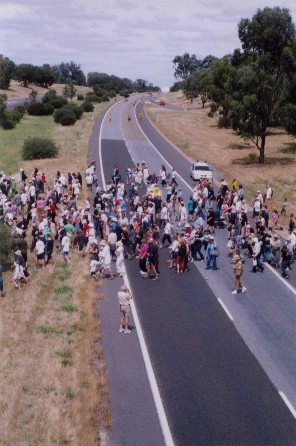
(Above) December 21, 2003: Local residents block Hume Highway for one hour to protest against the proposed toxic dump.
Immediate Concerns:
*Located in the catchment of the food bowl of Victoria.
*Site is prime agricultural land.
*Positioned on a flood plain where recent flooding has ocurred.

*Dump Ownership could be in hands of private operators
*Lack of consultation with landowners, adjoining landowners and the community.
*Against the "Green and Clean" direction promoted by Shire of Strathbogie.
*Located at the gateway to the NE snowfields and tourism of the area.
*Centre of the Heartlands Conservation Project.
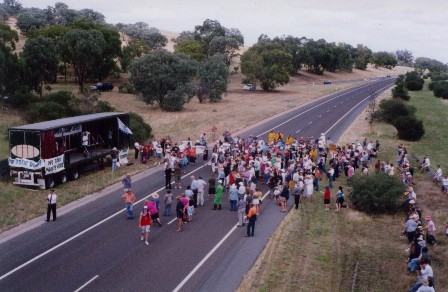
(Above) December 21, 2003: Local residents block Hume Highway for one hour to protest against the proposed toxic dump.

OTHER WASTE DUMP PROPOSAL SITES
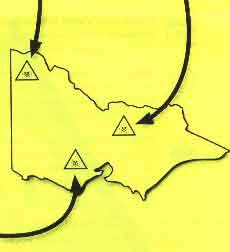
Ouyen (Tiega): Five hours from Melbourne and close to Ouyen, Tiega is in the heart of Mallee wheat country. The agricultural land around Tiega has a massive output and sustains a strong local economy. A toxic dump located in this town could devastate this industry and ruin the local economy. Further, residents along the Calder, Western and Sunraysia Highways will not appreciate huge trucks carrying toxic waste rumbling through their towns night and day.
Ballarat (Pittong): This area lies between Linton and Skipton, not far from Ballarat and just over about an hour and a half west of Melbourne. It is located in a prime agricultural and tourist area and has many beautiful creeks and streams close to the site where the State Government may build a toxic waste dump. The area's local Kaolin facility will have to be demolished as it is in the way of the proposed toxic dump facility, costing 40 local jobs. Further, one of the two Pittong waste sites has creeks that flow into Lake Corangamite - a declared RAMSAR wetlands area. An industrial site is a better location for a waste facility than this small country village.
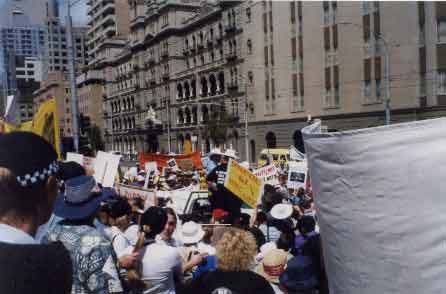
Thursday 4 March 2004: Hundreds of people rally outside Parliament House in Melbourne opposing the planned toxic waste dumps. People travelled from Pittong, Ouyen and Violet Town to attend this important rally. The rally received positive media throughout Victoria.
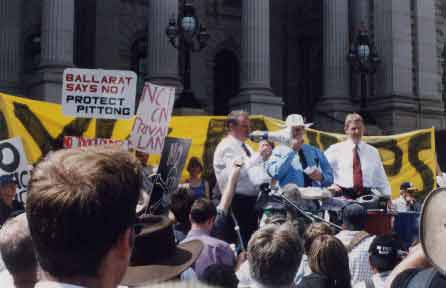
Thursday 4 March 2004: Robert 'Headmaster' Doyle, leader of the Victorian Liberals gives the punters a blast of hot air through the megaphone. Peter Ryan the head of the Victorian Nationals waits for his chance to speak. Both of these pollies were given petitions with thousands of names opposing the waste dump proposals in country Victoria.
Address Complaint Letters:
Hon Steve Bracks MLA
Hon Peter Batchelor MLA
Mr Bill Sykes MLA
Hon Robert Mitchell MLC
Hon John Thwaites
All at - Parliament House, Melbourne, 3000
Sophie Panopoulous - Federal Member for Indi
17 Murphy Street, Wangaratta.
